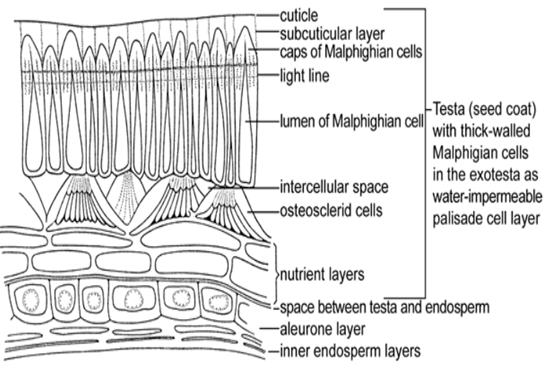Authors: Rajesh Kumar Sharma1and Mamta Nehra2
1Ph.D. Scholar, Dept. of Seed Science and Technology, CCSHAU, Hisar-125004
2Ph.D. Scholar, Dept. of Genetics and Plant Breeding, GBPUA&T, Pantnagar-263145
Introduction:
Seeds are fundamentally essential to people, not only because they constitute the principal method of plant propagation, but also because they afford an important food. A seed is a composition that contains at least an embryo and usually a supply of stored nutrients. Seeds of many species, however, lose viability after short period of storage, making their species prone to extermination and causing extensive losses. The seed coat is the outer coat of seed resultant from the integument. It is also called the "testa". Longevity of a seed is the period from seed maturation until seed death.

Fig. Structure of seed coat
Seed Coat as Physical Defense
Susceptibility to mechanical injury is a considerable factor in seed storability. Larger seeds live longer than smaller seeds and longer viability owing to a hard seed coat. Mechanical injury to seed reduces the storability. Removing the seed hull from rice, sorghum, delinting of cotton seeds and scarification in onion seeds increased electrolyte leakage, caused fungal and disease infection, reduced viability and germination rate. A waterproof or rigid seed coat provides the surest protection a seed can have against fluctuations in humidity and temperature which could damage the embryo or encourage growth of microorganisms. The arrangement of the embryo in relation to seed coats and other seed components may also affect seed storability. Peanut seeds lose viability due to damage to the radial tip, which is located under the seed coat and protrudes outside the cotyledons. Onion seed, a short lived seed, has its root tip located just under the protruding part of the seed coat.
Nutrient and Electrolyte Leakage:
In count to forming a physical barrier to microorganism infection, the seed coat in some way protects the seed from infection by restricting the diffusion of nutrients from the seed into the soil. Nutrients (carbohydrates and amino acids) diffuse into the soil when seeds imbibe, and contribute to the proliferation of pathogenic fungi instantly around the seeds. The increase in electrolyte leakage in deteriorated seeds is a sign of membrane deterioration, which is the key factor in the aging process.
Seed Coat and Microflora:
Bacterial and fungal infection plays a secondary role in seed deterioration. A major way in which microorganisms damage seeds is the production of exocellular enzymes and toxins. Among these enzymes, cellulases, pectinases, amylases, lipases, proteases and nucleases are likely to be importance. Microorganism infection may also cause an increase in electrolyte leakage, which is in fact due to the damage of the cell membrane and seed coverings. Microorganisms that infect seeds can come into through innate opening (micropyle) or through wounds, cracks. Some fungi enter directly through thin seed coats. Scanning electron microscopy (SEM) is a potent tool for detecting seed coat cracks and microflora in asymptomatic seed and could be helpful in determining seed longevity.
Seed Coat and Hydration Stress:
Seeds with scratched seed coats imbibe water rapidly. As a result their embryos are susceptible to imbibitional injury. This imbibitional chilling injury can be diminished by either retarding water uptake with polyethylene-glycol (PEG) or applying a thin coat of lanolin to the seed coat. Soybean seeds that were insensible to chilling injury could be rendered susceptible through scarification of the seed coats.
Phenolic Compounds in the Seed Coat:
Pigmented seed coats have a prolonged storage life. Beans (Phaseolus vulgaris) with pigmented seed coats perform superior in cold soils than white seeds (Dikson, 1971). Black seed coat soybean seeds imbibe water more slowly than unpigmented soybean seed and show a reduced amount of imbibitional chilling injury (Tully et al., 1981). Chickpeas with dark seed coats store better than lighter colored seed varieties. The resistance of colored seed coats to deterioration was a result of impermeable thick seed coats created by the oxidation of phenolic compounds by polyphenoloxidase or peroxidase. It was found that greater part of peroxidase activity in soybean seed was localized in the seed coat, suggesting that it may play a role in the hardening of the seed coat. Phenolic compounds in seed coats play another role in seed longevity and act as a chemical defense against microorganisms. Monomeric phenols, which are more soluble than polymerized forms, may acts as inhibitors to fungal growth and seed germination under humid storage conditions. Electrolyte leakage, however, may antagonize the inhibitory effect of phenols.
References:
1.Dikson, M. H. 1971. Breeding beans, Phaseolus vulgaris L. for improved germination under unfavorable low temperature conditions. Crop Sci. 11: 848-850.
2. Tully, R. E., M. E. Musgrave & A. C. Leopold. 1981. The seed coat as a control of imbibitional chilling injury.Crop Sci. 21: 312-317.
About Author / Additional Info:
I am a Ph.D. student of seed science and technology at CCSHAU, Hisar (Haryana)